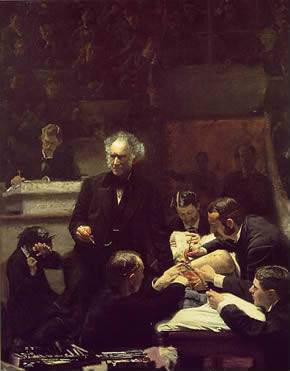
Thomas Eakins – The gross clinic

Augustus Saint-Gaudens’s Angel of Purity (Maria Mitchell Memorial),
Museum Presents Exhibition Focusing on Two Major Acquisitions for Philadelphia ]]>
In 2005, the Philadelphia Museum of Art acquired Augustus Saint-Gaudens’s Angel of Purity (Maria Mitchell Memorial), which had been commissioned for a church in Philadelphia where the stately marble was installed for over 100 years. A year and a half later, the Museum together with the Pennsylvania Academy of the Fine Arts acquired Thomas Eakins’s 1875 masterpiece, The Gross Clinic. In each case, a major work of art that might easily have been sold outside the city was identified as an important icon to keep for Philadelphia. In a triumph for the community, institutions and dedicated individuals successfully secured both treasures. These two master works will be placed on view together for the first time in Philadelphia Treasures: Eakins’s Gross Clinic and Saint-Gaudens’s Angel of Purity (August 2, 2008-February 2009).
Thomas Eakins and Augustus Saint-Gaudens were close contemporaries and friends. They trained in Paris and traveled in Europe before returning to the United States about 1870 to begin distinguished careers. Sharing a belief in the expressive power of the human body as a subject for modern painting and sculpture, they developed different styles. Eakins, committed to the depiction of contemporary life, celebrated the heroes of his own day—as in The Gross Clinic—in a grand and unsparing realism evoking the Dutch and Spanish masters of the 17th century. Saint-Gaudens, trained in the same tradition of naturalism and life study, fused the real with the ideal—as in The Angel of Purity–following the poetic spirit of neoclassicism. At the peak of their accomplishment in these two works, both masters demonstrate the power of great public art to stir profound and complex emotions grounded in themes of human life and death. Installed in public spaces in Philadelphia for more than a century, these two extraordinary works of art will continue to inspire audiences here, thanks to the support of many donors rallied by the Museum’s dedicated director, Anne d’Harnoncourt (1943-2008), who worked tirelessly to secure both treasures for the city.
The Angel of Purity was commissioned for St. Stephens Episcopal Church by Dr. S. Weir Mitchell and his wife Mary Cadwalader Mitchell after their daughter Maria Gouverneur Mitchell died in 1898 from diphtheria at age 22. The sculpture faced the Cadwalader family pew until it was removed early in 2004 to be sold by the Church. Saint-Gaudens based the work on his earlier Amor Caritas composition, made for the French state collections now housed in the Musée d’Orsay. For the Mitchell memorial, he reworked the angel’s crown and garland of passionflowers, revised the drapery, and redesigned the sculpture’s niche. Saint-Gaudens produced the final version in luminous white marble rather than bronze, making Angel of Purity unique in the Amor Caritas series, and one of his most beautiful creations. To save this masterpiece for Philadelphia, the Museum turned to the Annenberg Fund for Major Acquisitions, created by The Annenberg Foundation in response to a goal of the Museum’s 125th Anniversary Campaign.
The Gross Clinic, which has been acclaimed as the greatest American painting of the 19th century, has been an icon of Philadelphia since it was painted in 1875. The masterpiece of the young Eakins, an artist born and educated in Philadelphia, this painting sparked both controversy and praise at its first showing here in Philadelphia at the Centennial Exhibition in 1876, demonstrating the drama and force of character that set the tone for Eakins’s entire career. His masterful realism and his insistence on painting from modern American life shocked his contemporaries. More than a century later, his paintings of Schuylkill River oarsmen, Delaware River fishermen, and local painters, poets, priests, scientists, and educators have indelibly shaped a sense of Philadelphia’s identity—and its excellence in many professional fields. Purchased from Eakins and given to Jefferson Medical College by alumni in 1878, the painting was a source of inspiration to generations of students and doctors at Jefferson, and a pilgrimage site for visitors. In its decision to sell The Gross Clinic in 2006, Thomas Jefferson University offered Philadelphia institutions the right to match the price and acquire the painting, prompting an unprecedented outpouring of support to keep the masterpiece in the city. Thanks to contributions by more than 3,600 donors, the painting is now jointly owned by and exhibited in alternation at the Philadelphia Museum of Art and the Pennsylvania Academy of the Fine Arts, where the richness of history and context will deepen the meaning of this great work of art—a national treasure in its native city.
A portrait of Silas Weir Mitchell (1829-1914) by Robert William Vonnoh (American, 1853-1933) will also be on view. Dr. Mitchell was a friend of both Eakins and Saint-Gaudens and stood within the overlapping circles of science and art in Philadelphia at the turn of the 20th century. Born in this city and educated at the University of Pennsylvania and Jefferson Medical College, Mitchell became a specialist in nervous diseases and psychological disorders. In 1889, representing the trustees of the University of Pennsylvania, Dr. Mitchell accepted the gift of Eakins’s painting, The Agnew Clinic (on view in Gallery 116, on loan from the University’s Medical School). Vonnoh’s portrait of Dr. Mitchell was painted shortly before the death of Dr. Mitchell’s daughter and the commissioning of The Angel of Purity. The artist, who taught at the Pennsylvania Academy in the 1890s after Eakins’s departure, was proud of this portrait and exhibited it at the Society of American Artists in New York and at the Academy in 1908.
Also included in the installation are numerous works by Eakins and his contemporaries, including a portrait of Eakins by his wife, Susan Macdowell Eakins.
Follow us on:

